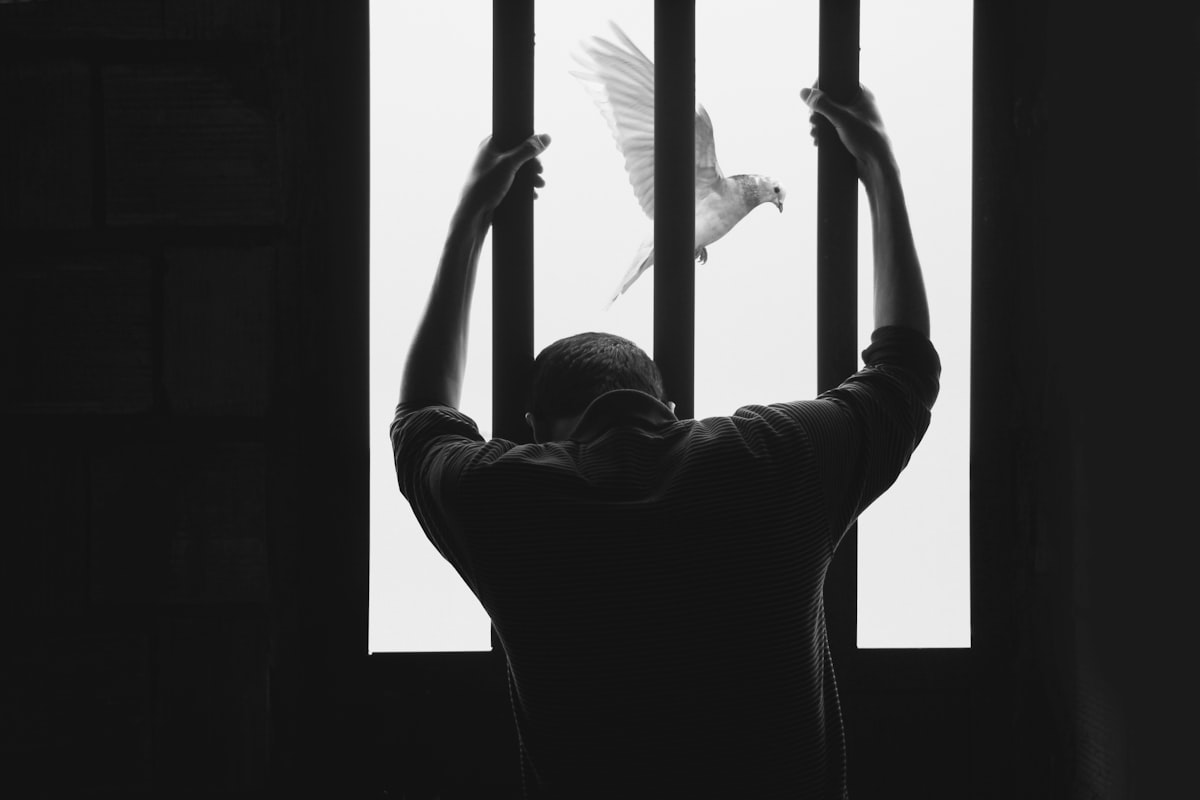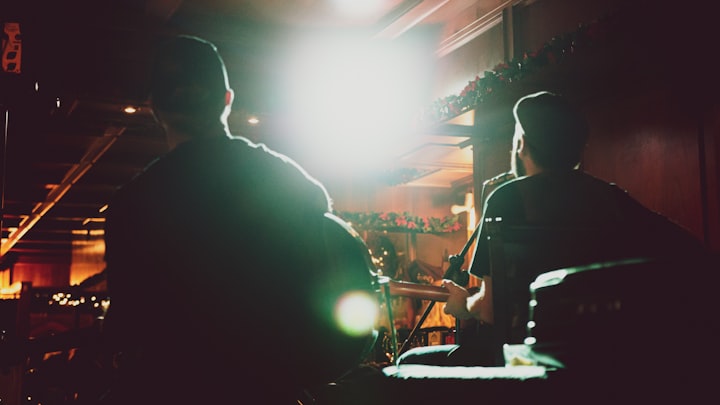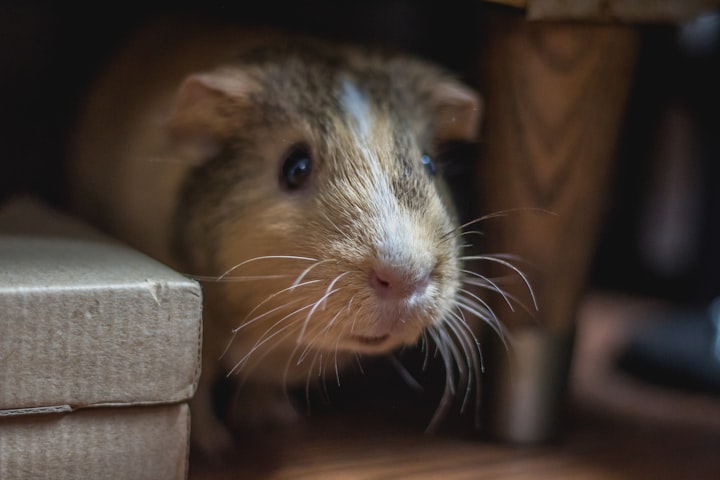Observations Regarding the Incarceration and Rehabilitation of Eastern State Penitentiary Prisoner Number C-98xx
At the trial, the convict’s mother, who wished to retain her dignity, sat stone-faced while the court pronounced her youngest son’s fate: first-degree murder, 30 years to life.

Author's Note: As a native Philadelphian, I’ve always been fascinated by Eastern State Penitentiary. Many years ago, when the old prison was still a crumbling wreck and visitors were required to wear hard hats and sign waivers to enter the grounds, I came upon a loose pile of photos that included a prisoner’s mugshot from 1934—a 14-year-old Black boy who had been incarcerated there for second-degree murder. I’d been moved by the mugshot—were those tears in his eyes?—and wondered who he was and what happened to him. But there was little information available at
the time.
I revisited the prison after it had undergone extensive renovations and more formal documentation of its history and found a display that featured the very mugshot that had haunted me for so long. Upon further research, I discovered among other things that the boy had died of pneumonia in 1941 while still serving his sentence. What might have happened if he’d lived? Thus was born the idea of fictionalizing his case set against the rise of the civil rights movement by bringing him back to life to witness the unfolding of events from within the prison walls from the 1930s to the 1960s. The story’s essay-like portions that relate the history of Eastern State and its changing philosophy of incarceration are based in fact, as are the historical events depicted. The rest is wishful thinking.
Eastern State Penitentiary Prisoner Number C-98xx cries as he sits in the unforgiving ladderback chair. He’s 12 years old, or maybe 14, the records are unclear. No matter. In either case, he’s the youngest inmate in the prison’s history. He’s waiting for the prison photographer, invisible under the black shroud that screens light from the camera’s eye, to fire the hand-held button that will preserve forever this moment in time. The tears against the inmate’s ebony skin appear crystalline in the harsh fluorescent that shines in his face.
In the mug shot’s head-on view, the most striking feature is a necklace of sorts: a metal placard suspended from a chain and hook device that indicates the boy’s new identity, C-98xx, and his date of incarceration, 8-30-1934. In the profile view is a steel rod fixed to the wooden ladderback, a vise-like tool to hold the prisoner’s head in place to prevent blurring of the photograph. The rod’s odd position makes it look as if a blunt knife plunges into the prisoner’s skull. The rod is 7.5 inches long and .75 inches in circumference. If you do the math, you’ll find that the rod has a volume of approximately 3.34 cubic inches, which is the result of plugging variables into the equation π r2h. Most Eastern State mug shots feature this rod. There’s nothing special about this boy’s case.
Prisoner C-98xx participated in the robbery and murder of a 62-year-old man out walking his dog in Fairmount Park on a moonless summer night. His older brother, who fled the scene, left baby brother to take the fall. Truth be told, the boy admitted to holding the old man down while his brother beat the man with a baseball bat. They didn’t intend to kill him, but he resisted giving up his wallet. They spared the dog, who subsequently sniffed and whined at his lifeless owner’s body.
At the trial, the convict’s mother, who wished to retain her dignity, sat stone-faced while the court pronounced her youngest son’s fate: first-degree murder, 30 years to life.
The judge had hoped to have the juvenile transferred from Philadelphia’s House of Correction, where he was held pending trial, to Huntington Reformatory, where he’d be housed with similarly young offenders and could take advantage of its educational and rehabilitative facilities. But due to a glitch in the justice system—that those sentenced in Philadelphia could only be assigned to Huntington at the end of the court term—the judge was forced to commit the convict to Eastern State.
“It’s an outrage,” the judge said, nodding to the boy’s mother. “But what choice do I have?”
“Spare me your sympathy, Judge,” an onlooker muttered and shook his head. A friend of the murder victim, he’d read in the local newspapers that the boy had already created serious disturbances at the House of Correction. He thought the sentence too lenient for someone who had robbed his friend of life and displayed the kind of violent tendencies that foretold a future, not of the potential for rehabilitation, but rather of recidivist criminal behavior.
Prisoner C-98xx has been assigned to the third floor of cellblock 14, a reinforced concrete, three-story building designated for first-time offenders under the age of 21. The prison is segregated, and the third floor houses only black prisoners.
Prisoner C-98xx is, for the time being, alone. His cell measures 11 feet long by 7 feet wide by 8.5 feet high. A vertical slit window allows scant light and air. The cell contains a small sink and an iron bed with a thin mattress. A red, leather-bound Gideon Bible rests on a threadbare woolen blanket.
Outside the weather is typical Philadelphia summer. The temperature is 92 degrees Fahrenheit, humidity 90%, barometric pressure falling. The air carries the stifling heaviness of a coming thunderstorm.
Prisoner C-98xx wipes away his tears, but they leave a salty residue that sparkles against his black skin. He thinks it lucky that inside his cell, it’s a bit less oppressive, the concrete walls retaining some of the prison’s chill morning dampness. A slight breeze filters through a jagged crack in the window. He stands tip-toe on his bed, touches the cool glass.
At the turn of the 19th century, the Society for Alleviating the Miseries of Public Prisons, whose membership was dominated by progressive Quakers and Episcopalians, created an innovative method of rehabilitation to be tested at Eastern State. The Society’s philosophy grew out of Enlightenment thinking that prison should offer the criminal the prospect of reformation rather than punishment. Thus, the Society proposed abandoning corporal punishment in favor of solitary confinement as a means to a noble end in what became known as the “Pennsylvania System.” The Society believed that God existed in every individual, and that the trials of solitude would allow criminals to find God in themselves.
The prison was designed to maximize the prisoner’s opportunity for this cloistered pursuit of transcendence and redemption. The original cells featured a circular glass skylight, affectionately known as the “Eye of God,” so that prisoners could bask in the idea that the Creator was watching (over) them through these heavenly portals. Likewise, earthly peepholes allowed the guards to observe inmates without being seen.
Isolation was taken seriously. Pock-marking the interior cellblock hallways, solid square doors opened to feeding slots through which meals could be served by an overseer’s gloved hand. Guards padded their feet so that their footfalls were muted. When leaving their cells, prisoners wore hoods to preserve their anonymity and to minimize the opportunity for social intercourse. Each cell was outfitted with a double door—a solid iron one for security and a wooden one for good measure. The doors were located on the cell’s exterior wall and exited into a private exercise yard enclosed by a ten-foot-high wall crowned with barbed wire. Prisoners were expected to stay fit through an hour of forced daily exercise.
Prisoners weren’t allowed visits from family or friends, but only from medical professionals, celebrities, or the press. These visitors were permitted access to the inmates for investigatory or publicity purposes—that is, to confirm and disseminate to the outside world how well the Pennsylvania System was working.
To be fair, the Society made certain concessions to humane interaction. Wardens were legally required to visit each prisoner twice a month, and overseers were obligated to check on prisoners three times a day. Inmates could even keep pets in their exercise yards for companionship.
Most importantly, prisoners were given Bibles, and all the time in the world to become penitent, to make amends, and ultimately, to find their keepers’ God within.
What the prisoners found in their prolonged seclusion was a kind of blackness from which there was no escape. What they found in their Bibles were words that could not be articulated in human tongues. Even their painstaking (and forbidden) method of communication—tapping on the very same pipes that carried their effluence to the outside world—did little to alleviate the torment of isolation.
Upon visiting the prison in 1842, Charles Dickens asserted that solitary confinement was no less than a “slow and daily tampering with the mysteries of the brain […] immeasurably worse than any torture of the body; and because its ghastly signs and tokens are not so palpable to the eye […] and it extorts few cries that human ears can hear; therefore I the more denounce it, as a secret punishment in which slumbering humanity is not roused up to stay.” Dickens wasn’t, of course, considered an expert in the science of criminal rehabilitation. He was, after all, merely a writer, and worse, a writer of popular serial fictions gobbled up by largely ignorant masses as an antidote to their otherwise circumscribed lives. He was later accused of making things up.
In the summer of 1935, the phrenologist Doctor Thomas James Eckleburg visits Eastern State to assess the sizes, shapes, and key areas of inmates’ craniums. Though the science had been largely discredited nearly a century before, some like the good doctor still insist on a correlation between the size and shape of the head, its bumps and concavities, and a person’s capacity toward good and evil. They believe that a disciplined examination and analysis of such characteristics in incarcerated individuals will create a database that can be used to predict criminal behavior, perhaps even to prevent such behavior by targeting those with features that suggest violent tendencies.
Proponents have assigned the “science” a fancy new name—psychognomy. Eastern State’s Warden Smith doesn’t see the harm in using his prisoners as subjects for scientific inquiry. Science can explain everything, he thinks. Warden Smith likes to imagine he’s in the vanguard of conquering social ills.
Doctor Eckleburg is thus particularly interested in the overall shape of Prisoner
C-98xx’s head and the bumps and depressions of area E36, which signify combativeness and aggression.
Doctor Eckleburg bends to measure the circumference, length, and width of Prisoner C-98xx’s head. His metal caliper is cold to the touch and sharply pointed. When he expands the prongs and places them between the prisoner’s ears, the boy cannot help but laugh at the itching-tickling sensation its touch engenders.
“Hold still,” the doctor commands.
The boy stops laughing.
Doctor Eckleburg then consults the official scale by which such measurements are judged. The categories range from the much-desired dolichocephalic, a fancy word for “long in the head,” in which the measurement from front to back is far greater than that from ear to ear—to scaphocephalic, the most unfortunate head type, which one writer has described as looking like “a boat turned bottom up.”
Doctor Eckleburg categorizes the overall shape of the boy’s head as subbrachycephalic—that is, very short—an indication of low intelligence. The doctor thinks this to be a generous assessment, as the boy’s elongated nose and receding chin suggest hyperbrachycephalisis, nothing short of imbecility. Moreover, he finds area E36 to be much larger than normal, especially in a boy so small. Such fine distinctions between excessive and normal E36 are what world-famous astrologian Edward Lyndoe suggests would distinguish the potential criminal from “the explorer, the hero, the energetic pioneer.”
“Little Man,” the good doctor says, and raps the boy’s receding chin with his closed fist in what he regards as a friendly gesture.
Dickens’s observations carried little weight with the recognized experts of his time, and so the Pennsylvania System continued for nearly a century more before being halted as cruel and unusual punishment. Abandonment of the System was partly the result of careful, peer-reviewed studies evidencing the deleterious psychological effects of protracted isolation. Psychology was a true science meant to replace phrenology, one that would finally solve the riddle of violence.
(Abandonment of the System was also practical, shall we say, the result of the explosion of the prison population and the need to double up the inmates in each cell.)
This isn’t to suggest that solitary confinement was discontinued at Eastern State. In fact, the guards invented a new form of the punishment for transgressive inmates: They allowed a Harvard University-educated architect—an Eastern State inmate serving time for fraud, no less—to design lightless, windowless underground holes measuring 5 by 8 feet with 6-foot ceilings. These holes had no plumbing, just buckets for human waste that were emptied twice a day (if the prisoner was lucky).
On Monday, August 30, 1954, a Monday much like every other Monday except that it marks the end of the twentieth year of Prisoner C-98xx’s incarceration, a guard named Frankie Palmer tells the boy—now a man—a story. It’s the story of Eastern State’s most famous escape, a story Prisoner C-98xx knows only too well because he was there when the breakout occurred. But he also knows better than to stop Palmer from telling the story for what seems like the hundredth time.
Back in ’45, Guard Palmer says, Kliney Klinedinst tried to dig his way outta here with Willie Sutton and his dirty dozen. Tunnel was 112 feet long. Imagine that! 112 feet! Have to say we guards were impressed. Slick Willie got the credit, but old Kliney, he was the mastermind. We caught ’em, of course. They spent time in the hole, years in solitary. Howlin’ by the end. Kinda makes you not want to do anything stupid, now don’t it?
As the science of psychology evolved in the 20th century, many of its practitioners came to believe that criminality could be attributed to environment, that is, to nurture rather than nature or to some arbitrary cranial characteristics. Indeed, they looked to childhood experiences: cold mothers, especially, but absentee fathers too. Not to mention predatory relatives, schoolyard bullies, and derelict brothers who abdicate responsibility for their crimes.
Friday, August 28, 1964. 9:35 P.M. 10,957 days have passed since Prisoner C-98xx’s incarceration.
Two Philadelphia police officers, Robert Wells and John Hoff, respond to a domestic dispute between an intoxicated husband and his wife. Wells is black, Hoff white. Mrs. Odessa Bradford sits inside her car, blocking the intersection of 22nd Street and Columbia Avenue in a neighborhood known as The Jungle. Her husband, Rush, stands outside the vehicle, knocking on the passenger-side window.
The police try to persuade Mrs. Bradford to move her car so that they can resolve the situation without holding up traffic at this busy intersection. When she resists and strikes the officers, they forcibly remove her from her car. The altercation attracts a crowd. One onlooker attacks the officers, thereby escalating what should have been a routine arrest. Uniformed reinforcements arrive to subdue the tensions. This lasts until a local agitator in the crowd shouts out that a pregnant black woman has been beaten and shot to death by a white policeman (a rumor later proven untrue). So ignites the Philadelphia riot of 1964, coming on the heels of similar riots blazing across the country.
Sound carries. In the near distance, through the now entirely missing pane in his iron-grated window, Prisoner C-98xx can hear the thuds of bricks and stones being thrown from rooftops, and the shattering of shop windows and hurled bottles as the crowds multiply, fan out through The Jungle.
Yes, sound carries. And the sound he hears as counterpoint to the din of breaking glass is a song rising.
It’s been a long time coming, but I know a change gonna come, oh yes it will.
The next evening, Prisoner C-98xx reads in the Philadelphia Bulletin that an altercation between police and Jungle residents has sparked riots and looting. Authorities blame the weather: mercury has stalled at 95 degrees, the humidity at 95%. The air itself is a shroud.
In truth, however, the winds of the civil rights movement have finally blown into this sleepy city, this City of Brotherly Love, where blighted neighborhoods fester in the summer heat. In the forties and fifties, city planners had thought that the solution to poverty, to devastated neighborhoods, was to invest in center city commercial infrastructure as a means of encouraging economic development. Construction companies vied for lucrative contracts, razed derelict housing, and erected airless, glass-walled skyscrapers in its place. Likewise, builders upgraded Suburban Station’s many train platforms and tunneled underground to create pedestrian shopping concourses to serve inbound commuters. These were the very people who had fled the city in recent decades for the safer, greener hills and valleys of the Philly suburbs. Planners convinced themselves that these policies would have a trickle-down effect, translate into jobs for everyone, raise even the most impoverished to a living wage. In turn, housing that had been destroyed would be rebuilt.
Urban renewal, it was called.
Instead, those left behind were displaced, crowded into smaller and smaller enclaves of substandard, overpriced housing, and crucially, deprived of a feeling of belonging anywhere.
Prisoner C-98xx continues to read about this troubled world outside his window, a world he hasn’t seen for thirty years. Despite the unrest, it’s a world he hopes to be released into very soon. His minimum sentence is almost up. On the handmade calendar he keeps in his cell, he’s circled the date in indelible blue. August 30.
That day is tomorrow. A Sunday. The Lord’s Day.
Despite evidence of its ineffectiveness as a means of rehabilitation, solitary confinement continued to be practiced throughout the 20th century. Its adherents invented a new name, calling it “restricted” or “segregated” housing. No longer did they pretend that rehabilitation was the objective. How else to punish murderers, or at the very least, to separate those dangerous elements from the general prison population?
Yet Prisoner C-98xx appears to be emblematic of rehabilitation’s possibilities. Due to the vagaries of the prison system, he’s done much of his hard time alone without obvious psychological repercussions. Moreover, he’s been a model prisoner, resisting prison riots and escape attempts, currying favor with the guards. The powers-that-be who will determine his fate congratulate themselves on his success. Have any of these higher powers considered that Prisoner C-98xx is, to use a cliché, the exception that proves the rule? That throughout his confinement he’s retained a childlike sense that patience, through a struggle with oneself, is its own reward?
For thirty years, Prisoner C-98xx has passed time marking passages in his Gideon Bible. Red scribbles obliterate page after page. In all these years, despite his best efforts, he hasn’t found God in himself.
Instead he reads the Bible as a book of fairy tales. He’s especially fond of Revelation 21:4: He will wipe away every tear from their eyes, and death shall be no more, neither shall there be mourning, nor crying…
His bookmark is a copy of his mug shot. Long ago, Warden Smith thoughtfully provided this memento, the only photo he has of himself. He’s long since lost touch with his family, who might have been a better source for such childhood keepsakes. He’d been told long ago that his brother was killed in a shootout with Philadelphia police in 1956, and that his mother passed away not long after. As for his father, who knows?
Prisoner C-98xx touches the face of the boy in the photograph, a boy he can’t remember. With his thumb, he rubs the tears bespattering the boy’s cheeks.
And then, he begins to hum. The hum swells to individual notes, and the notes coalesce around words he sings to himself.
It’s been a long time coming, but I know a change gonna come, oh yes it will. Oh, yes it will. Oh yes, it will.

Cynthia Reeves’s publishing credits include “Badlands” (MU Press 2008), which was awarded Miami University Press’s Novella Prize. Her fiction, essays, and poetry have appeared widely. She’s won numerous awards and honors, including prizes in Columbia’s Fiction Contest, the DeMott Short Prose Contest (Quarter After Eight), New Millennium’s Short Short Fiction Contest, and Potomac Review’s Fiction Contest; several nominations for the Pushcart Prize; and residencies at Hawthornden Castle, the Arctic Circle Summer Solstice Expedition, Galleri Svalbard, and Vermont Studio Center. A graduate of Warren Wilson College’s M.F.A. program, she’s taught in Bryn Mawr College’s Creative Writing Program and Rosemont College’s M.F.A. program.



